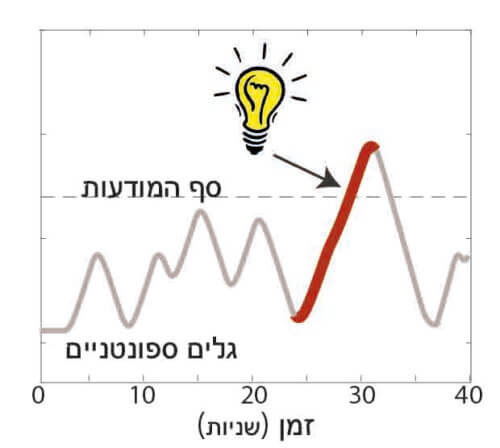A new study by Weizmann Institute of Science scientists offers an explanation for these magic moments, when new ideas sprout in us

Nikola Tesla invented the electric motor powered by alternating current while he was immersed in walking, Harry Potter was born in the mind of JK Rowling while she was stuck on a train - and Archimedes formulated his law of buoyancy while taking a bath. History is full of anecdotes about groundbreaking ideas that unexpectedly wound up from the depths of the unconscious. New research of the scientists of the Weizmann Institute of Science offers an explanation for these magic moments, when new ideas sprout in us. The researchers, led by Rotem Brodai-Dvir from the laboratory of Prof. Rafi Malach In the department of neurobiology at the institute, they recognized that brain activity that arises spontaneously and is called "resting waves", stimulates the emergence of creative thoughts. Researchers believe that this is a universal mechanism that underlies what is perhaps the most celebrated feature of the human brain: creativity.
What happens to the electrical activity in the brain when we are resting and not busy with any task or processing information coming from the outside? Already more than 20 years ago, Prof. Amiram Greenwald and Dr. Amos Arieli from the Department of Neurobiology at the Institute studied the mysterious phenomenon of spontaneous resting waves - extremely slow fluctuations of brain activity, which occur below the threshold of consciousness, as opposed to the short and fast bursts that characterize the conscious processes in the brain; Some likened these fluctuations to a kind of "Screensaver” that appears when the computer is not in use. These waves move between the different neural networks in the cerebral cortex, creating complex repetitive and even symmetrical patterns. Despite the fact that this is one of the most studied phenomena in the human brain, the question of how they are formed, and especially what their role is, remains a mystery.
Prof. Malach and others see resting waves as organized biological "noise" - random activity of nerve cells that causes them to transmit electrical signals spontaneously and at a relatively low level even in a state of rest. Similar to applause at the end of a theater performance, which at first sounds like random noise, but later synchronizes into rhythmic applause, the noise of the individual nerve cells also synchronizes thanks to the communication networks connecting the nerve cells in the brain, and the result is the appearance of resting waves.

Brodai-Dvir and Prof. Malach hypothesized that the spontaneous resting waves may have something to do with the wonderful creative capacity of the human brain. At first it will sound surprising that a phenomenon originating from biological noise would be offered such a significant role in the process of human creation, but there are many examples in both nature and engineering - from the theory of evolution to artificial intelligence networks - where random noise is used as a tool for solving problems and optimizing processes.
To examine this, the research team conducted a series of experiments, in which subjects were assigned various tasks known as tasks that examine free behavior in general and creative processes in particular - for example, finding new uses for familiar objects or finding different examples of a certain category ("noisy things") - while their brains were scanned using images Functional magnetic resonance imaging (fMRI). In all three tasks tested, the researchers saw that the report of the creative idea was preceded by a slow electrical activity similar in nature to the spontaneous resting waves. In the control tasks in which the subjects were not required to think creatively, the same areas of the cerebral cortex were active, but no preliminary slow waves were recorded. "We detected a slow wave that looked like resting waves, but how could we prove that these are indeed these waves?" Brodai-Dvir asks and answers: "Each person has slightly different characteristics of the waves of rest. Before performing the tasks, we characterized these waves in each subject, and later we showed a very high and significant correlation between the slow waves that preceded the creative behavior and the nature of the spontaneous resting waves of each subject."
The researchers clarify that although the origin of the resting waves is probably noise, it is important to understand that their activity is not completely random - since they operate within a system that has already been designed in a certain way; Organized noise, you can call it. "Our learning and talent shape the neural networks in a way that allows the spontaneous waves to produce creative ideas from them - each in the field of his talent and expertise and according to his level of interest," they explain. "The organized neural noise allows the creative person to take material he has learned, 'shake' it in an unusual way - and thus come up with original and new ideas."
Prof. Malach adds: "There is no need to exaggerate how much creativity is one of the most significant behavioral phenomena in human culture. This is the engine for all human progress - in culture, science and technology. Understanding the neural mechanism underlying creativity will be of great significance in identifying, and perhaps even enriching, creative processes in the human brain."
More of the topic in Hayadan:
